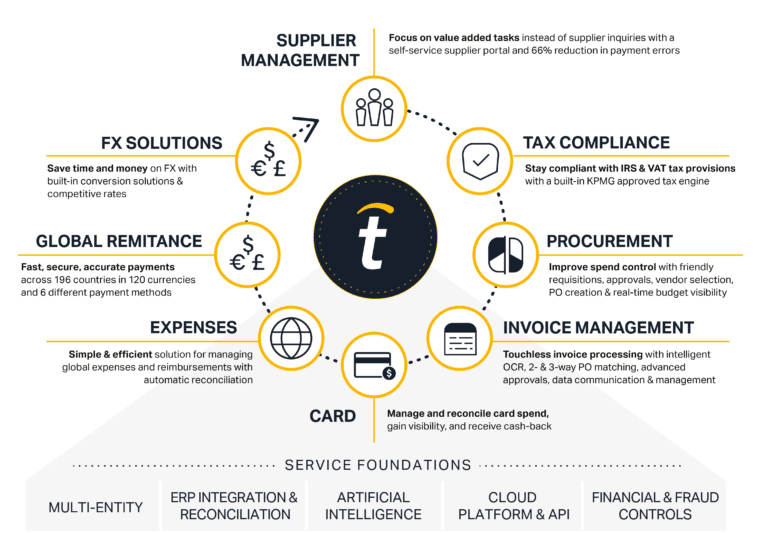The Total Guide to SAP ERP
Our guide covers everything you need to know about SAP ERP, including integration, market fit, pricing, features, and comparisons. Access our free e-book to learn more about automating accounts payable and global mass payments with SAP.
What is SAP ERP?
SAP ERP system is global software used company-wide with shared data to manage business processes in different business functions. SAP ERP Business One is for small businesses or subsidiaries. SAP Business ByDesign (competing with Oracle NetSuite) is for mid-market companies. Recent ERP versions are SAP S4/HANA Cloud and on-premises software or hybrid for mid-size and large enterprise customers.
SAP ERP operating systems include Microsoft Windows, Linux, and UNIX variants.
ERP software is for enterprise resource planning.
SAP, based in Germany, is a business software company founded in the 1970s by former IBM employees. The SAP meaning is an acronym that translates as Systems, Applications, and Products. SAP is considered a market leader in high-end ERP systems for data processing.
Features
Key Features and Benefits of SAP
SAP ERP provides these features and benefits, with the most robust features in the high-end SAP S/4HANA product.

Meets public, enterprise company requirements
SAP ERP on the cloud platform, on-premises, or hybrid offers software solutions that handle the most complex accounting, business operations, financial reporting, and real-time business intelligence with predictive analytics for decision-making for even the largest publicly traded global companies.

Feature-rich
SAP ERP features are robust, with an extensive list of optional modules available for functional areas within the business. SAP systems help businesses comply with applicable accounting standards for financial accounting and government regulations worldwide.

Handles global businesses and operations in 180 countries
SAP software is available in many languages of the countries in which it’s licensed to end-users. SAP ERP offers multi-currency recording and payments and multi-entity consolidation.

Data management framework, including data quality management, central governance, and data consolidation
The SAP data management framework includes data quality management, central governance, and data consolidation from data preparation for migration through system usage.

SAP HANA drill-down analysis
SAP HANA cloud software Includes multiple dimensions for drill-down analysis in real time.

Variant configuration and lifecycle management of products with SAP S/4HANA Cloud Public Edition
SAP S/4HANA uses super BOMs and super routing to create product configurations for manufacturing products and coordinate sales, engineering, and production. SAP offers product lifecycle management solutions starting with product development and combining business data and engineering models.

Contract accounting and invoicing in SAP S/4HANA
SAP HANA Cloud contract accounting and invoicing features work for subscription and consumption-based billing with contract-based receivables and payables accounting.

SAP S/4HANA for manufacturing
For manufacturers, SAP S/4HANA provides functionality for capacity plan simulation, material requirements planning (MRP), Kanban, and quality inspections.

Project management with Professional Services Automation (PSA)
Professional Services Automation (PSA) in SAP ERP is used to sell and plan more profitable service projects with early estimates for quotes, profit margin tracking analytics, and best practices throughout the engagement life cycle.

Robust procurement management features
SAP procurement is extensive and can be integrated with other SAP or third-party add-on software products.

Automatic Payment Program (APP)
The SAP Automatic Payment Program (APP) for mass payouts requires extensive setup.

Employee expenses automation requires non-ERP or third-party software integration
SAP ERP requires integrating a separate product for creating and reimbursing employee expense claims.
SAP HANA Sales integration with Microsoft Teams for collaboration
With Microsoft Teams integration with SAP HANA Sales, your sales team can collaborate on opportunities.
Choice of CRM for customer relationship management
CRM integration can be a choice of using SAP CRM or third-party Salesforce.
Applies artificial intelligence, machine learning, the Internet of Things, and blockchain
Intelligent technologies in the Business Technology Platform (SAP BTP) include AI, ML, IoT, and blockchain, which can improve business intelligence, also monitor equipment for breakdowns and required maintenance, and reduce product defects.
Modules
SAP Modules
SAP S/4HANA modules handle financial management, manufacturing, supply chain management, procurement, sales, marketing, professional services automation, IT management, product development, product lifecycle management (PLM), and human capital management (HCM) for human resources. SAP Business Suite bundles SAP ERP modules beyond the core module, including CRM, as an all-in-one solution.

Finance for group reporting
SAP S/4HANA Finance for group reporting is used for multi-entity consolidation. It connects financial close processes and can accelerate the consolidation process.
Human Capital Management (HCM)
SAP S4/HANA Human Capital Management can be used for personnel management, including employee information, benefits, compensation planning, and talent management. HCM can be used with payroll integration using timesheets.


Supply Chain Management
SAP S4/HANA Supply Chain Management is used to plan and optimize inventory stock and movement, check the availability of products when ordering, and handle shipping, warehousing, and transportation.
Ready for a completely streamlined AP experience?
ERPs are crucial for finance and accounting, but they often miss full AP management. Learn how companies bridge the gap, tackle global payment challenges, reduce risk, and find strategic opportunities.
Industries
Industries Using SAP
The largest companies and small businesses to medium-sized enterprises (SME), in a wide range of industries, use the SAP ERP software. These businesses use targeted products that fit their business needs and budgets. Most Fortune 1000 companies are SAP customers.
Multi-national businesses use the SAP ERP system, which is offered in many languages. SAP handles multi-currency transactions and payments, different accounting standards, and government regulations compliance by country.
Public companies that need abundant SAP features that meet their financial reporting requirements use SAP ERP.
Businesses using SAP Cloud ERP include these industries:

Energy and natural resources

High tech

Service industries

Automotive and industrial
Aerospace and defense

Building products

Chemicals
Online services

Financial services

Consumer industries, including retail and wholesale

Healthcare and life sciences

Higher education

Advertising technology

Video and digital media

Music companies and art museums
Companies with needs for production planning, material management, warehouse management, manufacturing, quality management, and project management use the SAP business management system. Google is a large enterprise SAP S/4HANA ERP customer.
Implementation
How to Implement and Use SAP
- Create a plan to implement SAP.
- Choose third-party add-on software.
- Use experienced SAP consultants, IT staff, and employees from each business application
- Get buy-in throughout the organization.
- Complete SAP ERP training for your business applications
- Review your business processes using SAP ERP’s Business Blueprint.
- View SAP videos.
- Read online resources from customer support, including the SAP Portal for Help.

Step 1
Team
Establish a multi-functional employee implementation team with a leader. Have the CEO or other executive management communicate the importance of the SAP project implementation to all employees.

Step 2
Consultant
Use an SAP consultant to offer guidance and assist planning.

Step 3
Implementation planning
Use implementation team collaboration to set goals, assign tasks, and set milestones and deadlines. Plan third-party software add-ons to SAP ERP. Review business processes using the SAP Business Blueprint.

Step 4
Training
Train the implementation team and functional users on how to use SAP ERP.

Step 5
Data migration and system testing, then going live
Clean and migrate data to the new SAP ERP. Test the SAP ERP in a sandbox environment before going live.
Step 6
Post-implementation review
Gather feedback from the implementation team to document the successes and areas for improvement in a report to make the next software implementation better.
How Does AP Automation Software Integration Work With SAP?
AP automation software integrates seamlessly with SAP ERP solutions through a flat-file or API connection. Tipalti payables and payments automation SaaS add-on software uses flat-file integration with SAP ERP, which efficiently handles the largest global mass payments. Tipalti streamlines and reduces accounts payable workflows and fraud risks, beginning with self-service supplier onboarding.
Tipalti AP automation software features include:
- Multi-entity, multi-currency, and real-time
- Self-service onboarding through a Supplier Hub
- W-9 or W-8 form data collection
- Choice of preferred electronic payment method
- Contact information and payment information
- Supplier validation with TIN (taxpayer ID) database checking with the IRS in the United States
- Digital capture of supplier invoice headings and line items using OCR and AI
- Application of 26,000+ payment rules to detect errors and duplicate invoices
- Automated global regulatory compliance
- Automated 3-way or 2-way matching with purchase order (PO) and receiving data
- Automatic general ledger account coding with generative AI
- Robotic process automation for routine tasks
- Routed approvals using email and Slack and communications with approvers
- Supplier invoice and payment status and history in the Supplier Hub
- Global payments to 200+ countries in a choice of 120 currencies
- Large batch payment scheduling with cash requirements information
- Real-time payment reconciliation with the general ledger
- Spend visibility by category with each entity and combined views
- Ask Tipalti AI℠ digital assistant to answer your spend queries for business intelligence
- Metrics and KPI trends including Days Payable Outstanding (DPO)
- Integration and data syncing with SAP ERP
- Supplier payments tracking and simple 1099 and 1042-S preparation report or optional eFiling of 1099-MISC and 1099-NEC forms with partnered Zenwork Tax1099 software

Other Tipalti finance automation products that integrate with SAP ERP on Tipalti’s unified platform include Mass Payments, Procurement, Expenses, and two advanced FX products, Multi-FX and FX Hedging.
Tipalti also offers the Tipalti Card (via an application form and approval) as a corporate spending card. Approved Tipalti users can use the Tipalti Card issued to specific employees to control spending that doesn’t require a purchase order through the Procurement department (or reimbursement of their out-of-pocket costs).
Tipalti mass payments automates efficient large global payouts to creatives such as artists and musicians with royalties, publishers, advertising networks, influencers, affiliates, streamers, and independent contractors like freelancers. Tipalti mass payments software integrates with SAP ERP and some performance marketing system platforms that calculate payout amounts.
Tipalti Multi-FX software works with Tipalti AP automation and mass payments software to make supplier payments and payouts efficient in 30 supported global currencies, including simple and competitive foreign exchange conversion rates, using a centralized virtual payment account for all subsidiaries. Your company will not need to establish an international, regional bank network to make overseas payments. Tipalti Hedging software lets you lock in foreign exchange rates before paying invoices when due.
Tipalti Expenses works with AP automation software and a mobile app to automate expense claims from photo receipts, check submitted expenses for your company’s travel and expense policy compliance, and obtain approvals (or rejected expenses) through automatic routing. Global employee expenses are then reimbursed with the Tipalti AP automation software.
Tipalti Procurement automation software simplifies purchase requisition submission and approvals, with stakeholder views and status. Tipalti Procurement automatically creates a purchase order from the approved purchase requisition. Tipalti Procurement manages supplier onboarding, contracts, and document management.
How Much Does SAP Cost?
The cost for SAP Cloud ERP and other SAP Cloud software starts with a choice of two pricing models: (1) consumption-based on usage or (2) subscription-based. Add consulting, training and implementation, third-party add-on software, and SAP service costs. SAP ERP on-premises cost is a capital expenditure for a long-term license fee and adds customization costs. Besides its top-tier priced product, SAP offers lower-cost ERP software products to smaller companies.
Recommendations
